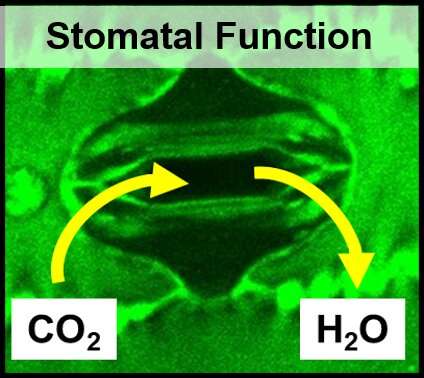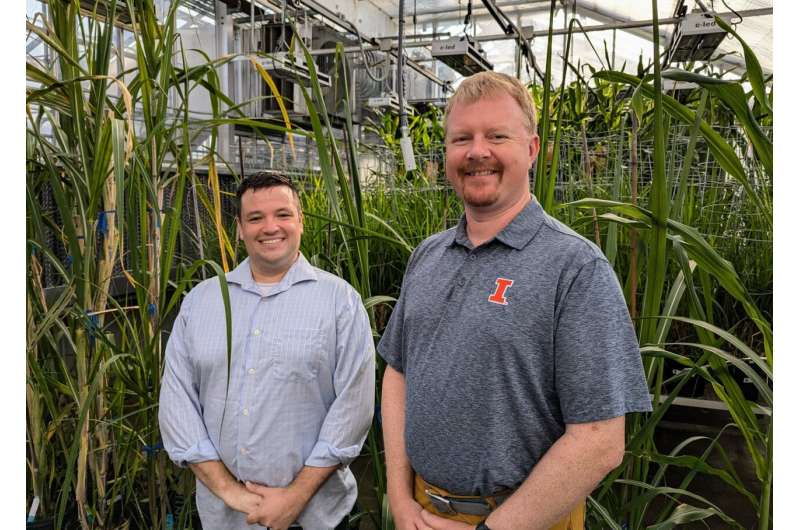This article has been reviewed according to Science X's editorial process and policies. Editors have highlighted the following attributes while ensuring the content's credibility:
fact-checked
peer-reviewed publication
trusted source
proofread
Research team designs efficient bioenergy crops that need less water to grow

Drought stress has long been a limiting factor for crop production around the world, a challenge exacerbated by climate change.
For more than a century, scientists have targeted a key plant trait known as water use efficiency (WUE) to help crops grow with less water and avoid suffering from drought stress. Greater WUE can help plants avoid drought stress—but for most crops it's also associated with lower productivity when water is plentiful.
In a pair of studies published in the Journal of Experimental Botany, researchers at the Center for Advanced Bioenergy and Bioproducts Innovation (CABBI) used genetic engineering to advance improvement of WUE in climate-friendly C4 bioenergy crops without sacrificing yield, a significant advance for the development of a sustainable bioeconomy.
In the first study, the CABBI team was able to reduce the amount of water escaping from sorghum plants by decreasing the number of stomata, or pores, on the leaf surface, improving WUE without limiting photosynthesis and biomass production. Researchers inserted a gene into the plants that altered their developmental pattern and reduced stomatal density.
"With C4 species, we think we can get a free lunch. We can have improved water use efficiency without having to compromise on how well the plant grows when it does have enough water. And that's a special case," said CABBI Director Andrew Leakey, team leader on the two studies.
Researchers in the second study discovered that reducing stomatal density in sugarcane and other C4 crops coincided with the pores opening wider. This offset some of the expected improvement in WUE.

The underlying mechanism for this response isn't fully understood, so the discovery represents a valuable new target for engineering an even more efficient plant.
Together, these findings will help maximize bioenergy feedstock production, aid crops in mitigating the effects of inadequate water supply, and open up new avenues of plant research, said Leakey, the Michael Aiken Chair and Professor in the Departments of Plant Biology and Crop Sciences and the Carl R. Woese Institute of Genomic Biology (IGB) at the University of Illinois Urbana-Champaign.
"It provides an exciting opportunity for new scientific discovery and engineering strategies," said CABBI Postdoctoral Researcher Daniel Lunn of Plant Biology, IGB, and the Center for Digital Agriculture at Illinois, primary author on the sugarcane study.
Major CABBI collaborators on this research included Feedstock Production Co-PIs Tom Clemente, Eugene W. Price Distinguished Professor of Biotechnology at the University of Nebraska, and Fredy Altpeter, Professor of Agronomy at the University of Florida. The primary author of the sorghum paper was John Ferguson, a former Postdoctoral Researcher at IGB.
During photosynthesis in plants, light energy is captured and used to convert water and carbon dioxide (CO2) into energy-rich organic compounds.
Water use efficiency refers to how much photosynthetic carbon gain a plant achieves—or more generally, how much biomass is being produced—relative to the amount of water it uses. In these studies, researchers focused on the leaf level, measuring the amount of water and CO2 going in and out through the stomata.
In the vast majority of plants, and the vast majority of efforts to boost WUE in plants, scientists face a tradeoff that stifles crop improvement: Making them more water efficient reduces their inherent productivity, photosynthetic carbon gain, and growth rate. "And so they do better when they don't have enough water, but they do worse when they do have enough water. From a broader agricultural perspective, that's a pretty undesirable tradeoff," Leakey said.

But C4 crops—including sorghum, sugarcane, and miscanthus, CABBI's target bioenergy crops—are built differently. They have a "fuel-injected version of photosynthesis" that concentrates CO2 inside the leaf before capturing it, "whereas most plants are like a Model T Ford, where they're running on a naturally aspirated engine," Leakey said.
Although C4 crops make up only 5% of all plant species, they're becoming more vital to agricultural production of food, fuel, and fiber. They are important examples of emerging biomass crops, including canes and miscanthus, that sequester carbon while providing a foundation for making bioproducts.
With the new WUE research, "we're taking the plants that already have an advantage as crops and then potentially making them even better without any drag on carbon gain," Leakey said.
The team is exploring this engineering approach in more CABBI plant species and fine-tuning the design. Groundbreaking work on miscanthus by other researchers on CABBI's Feedstock Production team—sequencing the miscanthus genome and developing the first gene-editing techniques—will "allow us to pursue this engineering strategy in a very important, emerging perennial feedstock crop that is capable of sequestering a lot of carbon," Leakey said.
"Overcoming water limitations to crop production is really very central to achieving our mission of underpinning a profitable, sustainable, and resilient bioeconomy," he added.
Leaves, roots, and other plant features have evolved to deal with the fundamental tradeoff between carbon gain and water loss in photosynthesis, and those processes have an overriding impact on where crops can grow without irrigation, Leakey said.
Developing crops that need 10% to 20% less water could expand the U.S. rainfed agricultural region further west, and allow farmers in the current growing zone to maintain profitable harvests even in years without sufficient rainfall—a more frequent threat under climate change.
"Part of what we're trying to do here is maintain increased productivity in times and places where water supply is inadequate," Leakey said.
More information: John N Ferguson et al, Reducing stomatal density by expression of a synthetic epidermal patterning factor increases leaf intrinsic water use efficiency and reduces plant water use in a C4 crop, Journal of Experimental Botany (2024). DOI: 10.1093/jxb/erae289
Daniel Lunn et al, Greater aperture counteracts effects of reduced stomatal density on water use efficiency: a case study on sugarcane and meta-analysis, Journal of Experimental Botany (2024). DOI: 10.1093/jxb/erae271
Journal information: Journal of Experimental Botany,
Provided by University of Illinois at Urbana-Champaign





















